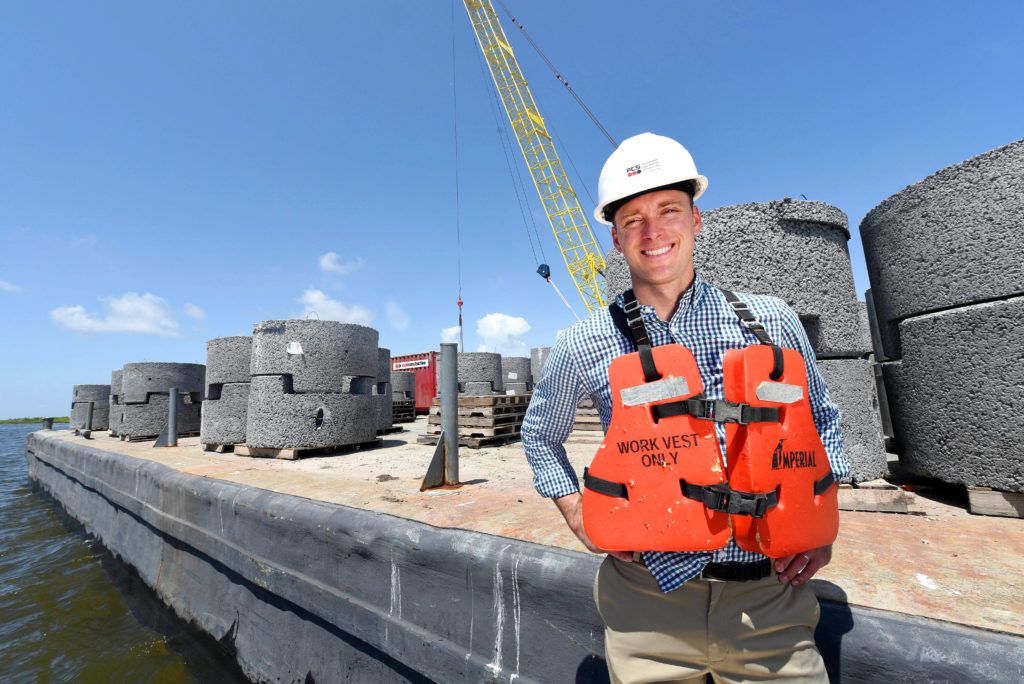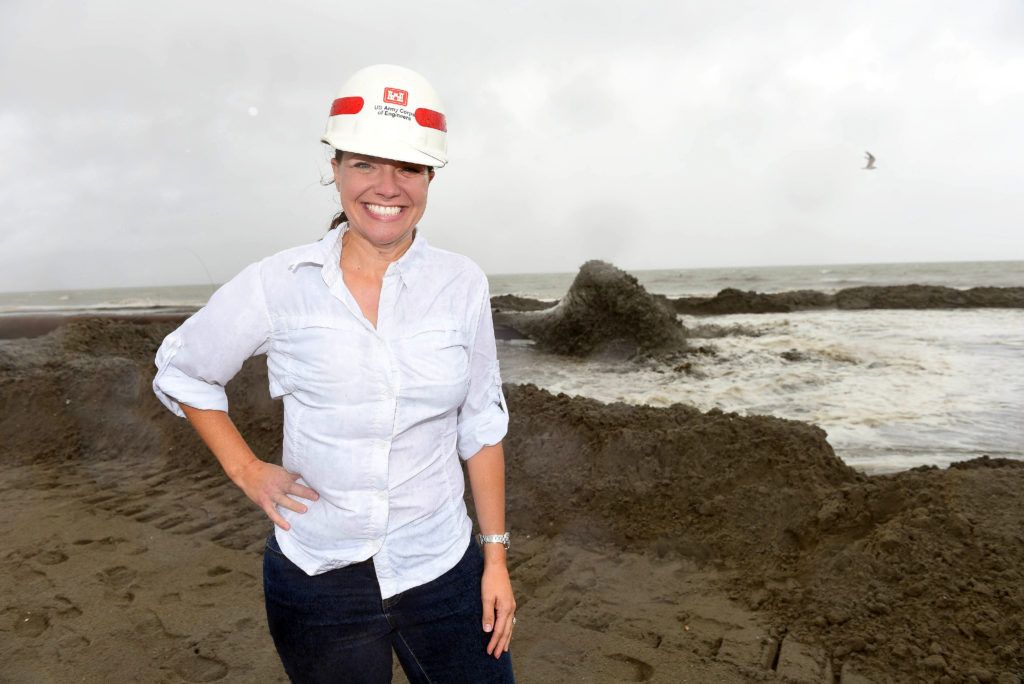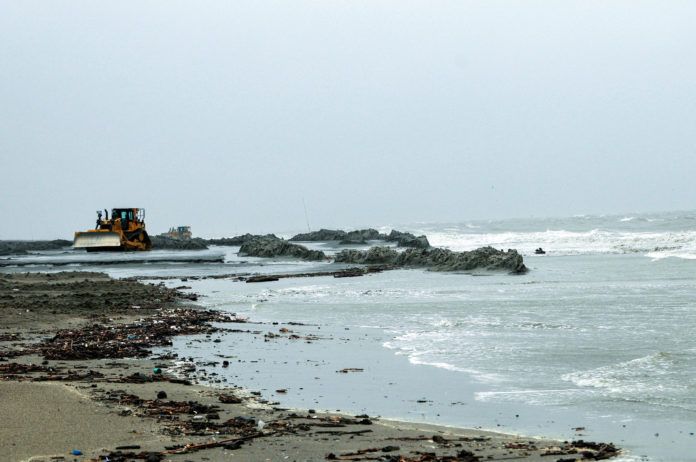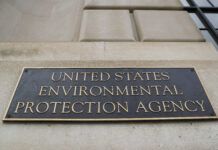Tension between development and the environment is not a uniquely Louisiana issue. From logging in the Pacific Northwest to fracking in water-scarce states, the search for balancing development and economic activity with the environment and its essential natural processes has been debated around the country—and around the world—for years.
The most prominent way this issue plays out in the Bayou State occurs along the coast, where land loss and damage has resulted in a loss of 1,880 square miles of land from 1932 to 2010. This land loss continues today, with an estimated 25-30 square miles lost each year along Louisiana’s coast—or another 1,750 square miles at risk of being lost by 2060. The energy industry—particularly oil and gas production—has often been blamed for the damage. Recently, four coastal parishes filed several lawsuits, drawing attention to the industry’s impact on the health and sustainability of the coast and, once again, highlighting the conflicted relationship between industry and the environment.
As The Associated Press reported in July, Vermilion Parish is suing dozens of oil and natural gas companies over damage the parish’s district attorney says drilling caused to the coast. District Attorney Keith Stutes filed the lawsuit in state court. Vermilion is the fourth parish to file suit against oil and gas companies over such claims, joining Cameron, Jefferson and Plaquemines parishes.
The suits accuse oil and gas companies of violating coastal permits or not obtaining permits when they dug oil access canals and dumped toxic waste into pits along the coast.
The oil industry dismisses the suits as being without merit and says companies have followed the rules. Yet those involved in coastal restoration and protection, as well as industry itself, contend that this tension is typically oversimplified. In reality, the relationship is much more interdependent and cooperative. Further, they point out that the factors that led to coastal damage and land loss are too complex and broad to lay at the feet of just one industry.
“There are so many factors to how we got here today. It’s always easy to pit two different sides against each other, but it’s more complex than that. Mistakes were made across the board,” says Simone Maloz, executive director of Restore or Retreat, a nonprofit coastal advocacy organization that identifies and implements large-scale restoration projects across the Barataria and Terrebonne basins. “We have to learn from those mistakes and move forward.”
More important than assigning blame, Maloz and others say, is ensuring all stakeholders are committed to restoring and protecting the coast today.
“Most of the conversations where you see tensions are over what happened in the past,” says Scott Kirkpatrick, president of Coast Builders Coalition, a nonprofit trade association comprised of private sector companies in the business of restoring and protecting the Gulf Coast. “Certainly things happened in the past, but going forward we see more of a common mission to be responsible. There’s been a paradigm change in what’s happened along the coast.”

KATRINA AND THE CPRA
Many cite Hurricane Katrina as the impetus for this paradigm shift. Katrina exposed the large-scale dire consequences and vulnerability of coastal land loss and resulted in reactionary expenditures of $250 billion. Without a healthy coast, future storms could replicate this.
“Attention, efforts and dollars to protect the coast have begun to flow since Katrina,” Kirkpatrick says. Before Katrina, between $100 million to $200 million annually was spent on coastal restoration and protection efforts, but post-Katrina this figure has risen to $1 billion annually, he says.
Hurricane Katrina also led to governance changes. After Katrina and Rita, the State Legislature established the Coastal Protection and Restoration Authority and required it to develop a plan for building a safe and sustainable coast. The state’s first Coastal Master Plan was published in 2007. Updates are required every five years, with the next update due in 2017.
Last year, CPRA reported findings of research it commissioned from the LSU Economics & Policy Research Group and the RAND Corp. This research found that increases in storm damage to capital stock (nonresidential structures, pipelines, etc.) due to Louisiana’s coastal land loss range from less than $10 billion to as much as $133 billion at 50 years. Even more daunting, the research found, were storm damage impacts to future economic activity if no coastal restoration actions are taken, ranging between $5 billion and $51 billion nationwide from a single storm event in 50 years.
Louisiana’s Coastal Master Plan stresses the urgency of restoring the coast: “Barrier islands, marshes and swamps throughout our coast reduce incoming storm surge, helping to reduce flooding impacts. If we continue to lose these habitats, the vulnerability of communities, nationally important navigation routes and energy infrastructure will increase substantially.” The master plan goes on to cite both man-made and natural factors that have led to this land loss. These factors include dredging canals for oil and gas exploration, building levees and floodgates that channeled the Mississippi River, sea level rise, subsidence, storms and invasive species.
A WORKING COAST
Underscoring the critical need to combat coastal land loss is the recognition that Louisiana’s marshy coast is primarily a working coast and not a vacation destination like other coastal areas. This concept of a working coast is emphasized in CPRA’s Louisiana’s Coastal Master Plan, which lays out specific actions and projects for restoring and protecting the coast. A key partner in these actions and projects is industry.
“Our mandate is to protect the citizens of Louisiana and restore the coast by developing, implementing and enforcing a comprehensive coastal protection and restoration master plan,” says Michael Ellis, CPRA’s executive director. “We involve stakeholders, including fisheries, oil and gas, and navigation, through focus groups that dive deeply into coastal issues. Some of our best partners are industry. We all know we need to co-exist.”
Kirkpatrick adds that focusing on the state’s working coast provides a more inclusive approach to coastal management.
“I appreciate it when people talk about Louisiana’s coast as a working coast because that distinguishes us from other coastal areas that are more focused on resorts,” he says. “A great element of being a sportsman’s paradise is so many people who work along the coast also live and recreate along the coast, so they have seen the degradation and the impacts of land loss.”
Louisiana’s coast is home to more than 2 million people. In addition to having homes and being part of coastal communities, many of these residents work for industries on the coast, including energy, fisheries and transport, as south Louisiana is also home to global energy companies and other multinational industries.
“There’s a lot more understanding of the needs of industry,” Ellis says, citing the oil and gas focus group that contributed to development of the 2012 Coastal Master Plan. “One of the things we heard from that focus group is ‘we want more land to protect our infrastructure and we need a more sustainable coast.’ That was a little bit of a surprise.”

Indeed, the industries typically blamed for damage are just as reliant on a sustainable coast as other industries and residents and communities.
“Working out of all the different ports along the coast are thousands of our employees,” says Don Briggs, president of the Louisiana Oil and Gas Association. “Looking at a map, you can see all the infrastructure we have on the coast and how that is a huge artery that feeds the rest of the country. So, our industry is very much a part of the coast, and coastal issues are extremely important for our industry.”
Industries that work along the coast are an economic engine for the state. Yet, without a healthy sustainable coast, these industries could not survive.
“Whether you’re talking about oil and gas, navigation, manufacturing—anything in this working coast has an interest in Louisiana’s coastal environment’s well-being,” Maloz says. “You can’t have a business here if we don’t have a coast.”
Vic Lafont, CEO of the South Louisiana Economic Council, agrees. “We’re literally a society that lives on the water’s edge,” he says. “We have to co-exist with the environment, and not just oil and gas, but other industries, such as seafood and agriculture.”
ACCESS AND FUNDING
Yet Briggs says lawsuits blaming the energy industry ultimately hurt the state’s economy. At a time when industry needs investment dollars for exploration, Briggs says, those dollars will not flow into Louisiana’s coastal area. Further, Briggs says, lawsuits filed by four coastal parishes for violations of coastal zone permits, which are the same type of permits industry is currently regulated by, will prohibit investment.
Still, the energy industry has a good relationship with those working on the coast, he says. Indeed, industry and coastal restoration work together in a number of ways.
For example, energy companies are some of the largest coastal landowners and providing access to their land has made many restoration projects, including marsh and other habitat restoration, shoreline protection, and freshwater and sediment diversions, viable.
“A number of restoration test projects we’ve done have occurred on the property of large coastal landowners that happen to be energy companies,” says Bren Haase, chief of planning for CPRA. “They’ve provided us right of access to their property for various projects.”
Maloz says working with private landowners is essential for success.
“You have to engage the landowner because almost every restoration project has some connection with private land,” Maloz says. “Their property is affected by coastal damage and erosion, too.” Maloz adds that landowners have “a tremendous ecological knowledge of their land,” which is an asset in identifying and implementing restoration and protection projects.
Another example of industry support for coastal restoration is an online data viewer, which Shell funded. Users input an address and the viewer will show current and future flood risk, as well as resilience options, thus enhancing awareness and understanding of the critical situation that will result without coastal restoration and protection.
Industry also is a primary funding source for the state’s restoration activities. For example, through the Gulf of Mexico Energy Security Act—dubbed GOMESA—37.5% of revenues from oil and gas leasing activities go to Louisiana and other states bordering the Gulf of Mexico. In 2006, Louisiana citizens voted to dedicate this funding to coastal protection and restoration in the state.

THE INDUSTRY OF RESTORATION
The critical and urgent need to restore the coast and protect it from further land loss has also buoyed Louisiana’s water management industry, the firms, organizations and professionals who restore and protect the coast, most of which are Louisiana-based businesses.
The relationship between the water management and energy industries illustrates how both are working toward the common goal of a healthy, sustainable coast. Indeed, Kirkpatrick notes, “A lot of our members do work for oil and gas companies as well as environmental mitigation banks, so we have clients in both camps.”
Maloz adds: “The water management sector and the oil and gas sector working together is an interesting, new dynamic. It’s taken 10 years since Katrina to build these relationships and they’re working. That might seem like strange bedfellows, but, at the end of the day, we have the same interests.”
As the water management industry has grown, it provides an opportunity for economic diversification during downturns in the energy industry, as many skills are transferrable between the energy and water management sectors. For example, surveyors working in oil and gas could work on coastal restoration projects. And, as more funding for coastal restoration becomes available, more jobs will be available, the South Louisiana Economic Council’s Lafont adds.
“There are coastal restoration funds coming down the pike creating jobs that weren’t here before,” he says. “We’re preparing our region for that inflow of funding and activity. This involves knowing what jobs will be available, polling communities to see who has that skill set, getting our community colleges ready to prepare our people and discerning how our smaller firms can be prepared to participate. We’re connecting the dots.”
Further, the knowledge and skills that workers are learning in dealing with coastal issues in south Louisiana could be applied elsewhere, allowing Louisiana to export this knowledge and further support the economy.
The success that Louisiana has achieved in coastal restoration “really highlights the fact that coastal Louisiana is on the cutting edge of these issues,” Haase says. “Louisiana is at the forefront of what the rest of the world will soon be dealing with.” Indeed, Haase observes that coastal erosion and damage ““is not just a Louisiana problem, it’s a problem of national significance.”
Ultimately, coastal protection and restoration would not succeed without industry’s involvement. This does not mean tension does not exist, but many of those involved in coastal restoration and protection are concerned today with focusing on combating both the man-made and natural processes causing coastal damage into the future.
That, Maloz says, is the driving force behind a more cooperative relationship.
“We’re in a critical time. We need to take advantage of all this momentum,” she says. “If we don’t achieve, we’ll have to face some harsh realities. We certainly have such a vested interest in the future of coastal Louisiana. I think both sides know it has to work. In any good relationships, there’s give on both sides. We have to get there or everyone’s going to lose.”
Haase agrees. “Certain things were done, not just by industry, that have had impacts on our coast,” he says. “There’s a role for industry for what has happened and what will happen. It’s not an either/or situation. The two are very intricately woven together. Without a healthy, resilient working coast, we can’t provide a good economy. The two are inseparable.”
Originally published in the third quarter 2016 edition of 10/12 Industry Report.









